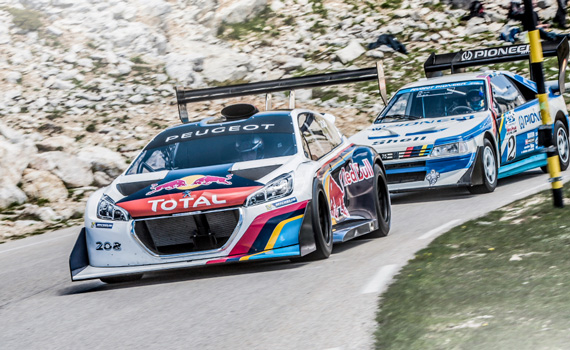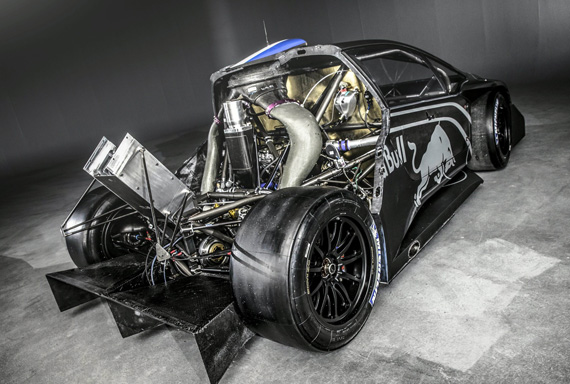By Roberto Motta
Photos courtesy of Peugeot Sport
On 30 June, nine-time world rally champion Sebastien Loeb and a fantastic new Peugeot 208 T16 will start in the most famous hillclimb race in the world: Pikes Peak.
The event marks the return of the French team at the traditional hillclimb after the memorable one-two wins on the same mountain in 1988 and 1989.
The Peugeot Sport team went to the famous Mont Ventoux in the south of France, in an attempt to simulate conditions at Pikes Peak. The French route, while not the same altitude reached in the Pikes Peak, (where you can reach 4,301 meters), nevertheless has similar characteristics.

The new 208 T16 leading the 1989 408 T16 in tests in France. Perhaps Peugeot plans to re-enter the U.S. market?
During the test, the 208 T16 was shown in its final livery, and faced the uphill challenge alongside its ancestor, the 405 T16 which won Pikes Peak in 1988 with Ari Vatanen.
Prepared by Peugeot Sport, the new car is powered by a 3.2 V6 twin-turbo created for endurance races and centrally located, as in the 205 T16 Group B rally car.
Faster than an F1 Car
The V6 delivers 875 horsepower and 90 kgm of torque.
Derived from the 208 road car, the “Pikes Peak” is actually a real ‘animal’ that uses an engine and aerodynamics designed solely on the basis of the tortuous path that the car will face in Colorado.
Looking at it closely, we can see that its shape is reminiscent of the road car only in the shape of the headlights, some parts of the body and the glass; everything else has been expanded to the extreme by designers Michael Trouvé and Attila Bocsi.
The design team learned from previous experiences on Peugeot race cars, and more particularly from lessons learned in 1988 and 1989 when Ari Vatanen and Bobby Unser won the race with the 405 T16.
The “Pikes Peak” uses a body made of carbon fiber, with a multitude of huge and aerodynamic aids, enabling it to remain literally glued to the ground, including the huge rear wing taken from the Peugeot 908 that won the 24 Hours of Le Mans in 2009.
The specifications of the car are shocking, thanks to the awesome power developed by the turbo V6, and with a 6-speed sequential gearbox. It will accelerate from 0 to 100 km/h in 1 “8, 0 to 200 in 4 “8 and from 0 to 240, the maximum speed in just 7 seconds.
Finally, with a weight of only 875 kg, it has a power to weight ratio of 1 kg per hp.
“Really a Beast”
Last winter, after his first drive in the Peugeot 208 T16 Pikes Peak, Loeb said, “I’ve never driven a car with such acceleration! With the lower gears, even a Formula 1 does not deliver all its power, while here, just put it in gear and bam, bam, bam … with four-wheel drive and turbo, you find yourself getting to 240 kilomoters per hour in about six seconds. With this kind of acceleration the 208 T16 Pikes Peak is able to leave any F1 at the gate.
He added: “This is incredible power. Earlier, I was stunned every time I changed gear. Changes are so abrupt that it takes a short period of adaptation to anticipate the next gear. Fortunately you get used to it, but at the beginning it is really disconcerting.
“The brakes are impressive thanks to the downforce and the width of the tires. I would say the 208 is a pure mix of all the best of racing: Formula 1 aerodynamics, tires as wide as in the prototypes, and a transmission with a differential similar to the WRC. I have tried many types of racing cars, but the 208 T16 Pikes Peak gave me very different sensations. It has the acceleration, braking and grip of an F1 car. In addition, the four-wheel drive helps to make it stable. It has a lot of potential. It is really a beast.”
Now, after testing on the Mont Ventoux he added: “The 208 T16 Pikes Peak has great character on a real road. Testing on Mont Ventoux is useful to understand what we can expect at Pikes Peak. It is still very responsive to the steering wheel and I still can’t point it with the precision I want. We need to work more on this point.”
At the end of May, the Peugeot Sport team will leave for Colorado, where they will continue the development of the 208 T16 Pikes Peak.
The Pikes Peak International Hill Climb is the second oldest race in the U.S. after the Indianapolis 500. The first edition of Pikes Peak was held in 1916 and in recent years has been held on a completely paved road. The start of the time trial takes place at an altitude of 2,865 meters and, after a journey of about 20 km and 156 curves covering a vertical drop of 1,436, it reaches the finish line to the summit of 4,301 meters.
The Unlimited class in which the Peugeot 208 T16 Pikes Peak is entered, is a class where the only limit is the budget of the designers. Currently it is dominated by Nobuhiro “Monster” Tajima, a Japanese rider who has participated in the race since 1988 and is famous for the monstrous power of his Suzuki cars with 1000 horsepower. Tajima was the first rider in history to have broken the barrier of 10 minutes in 2011.
In Italia
LA PEUGEOT 208 T16 E LOEB ALL’ASSALTO DELLA PIKES PEAK INTERNATIONAL HILL CLIMB
By Roberto Motta
Photos courtesy of Peugeot Sport
Il prossimo 30 giugno il nove volte campione del mondo rally Sébastien Loeb e la Peugeot 208 T16 prenderanno il via nella più famosa gara in salita al mondo: la Pikes Peak.
L’evento segna il ritorno del team francese alla tradizionale gara statunitense, dopo la memorabile doppietta sullo stesso tracciato nel 1988 e 1989.
Superati i primi collaudi funzionali, nelle mani dei piloti collaudatori, era giunta l’ora di provare l’auto su strada, e il team Peugeot Sport si è di recato sul Mont Ventoux, nel sud della Francia, sulle stesse strade del Tour de France di ciclismo, nel tentativo di simulare le condizioni di gara che la Peugeot 208 T16 Pikes Peak affronterà in Colorado. Il percorso francese, pur non consentendo di testare la meccanica alle stessa altitudine che si raggiunge nella Pikes Peak, dove si raggiungono i 4.301 mt, ha caratteristiche di tortuosità molto simili.
In occasione del test, la 208 T16 ha sfoggiato la livrea definitiva,e affrontato la salita affiancata dell’antenata 405 T16, vincitrice alla Pikes Peak nel 1988 con Ari Vatanen.
Preparata da Peugeot Sport, la nuova vettura è spinta da un V6 3.2 biturbo nato per le gare endurance e posizionato centralmente, come nella 205 T16 Gruppo B.
Il V6 eroga di 875 cavalli di potenza e sviluppa una coppia di 90 Kgm.
Derivata dalla 208 stradale, la “Pikes Peak” è in realtà una vero ‘animale’ da gara che sfrutta un propulsore e una aerodinamica studiati unicamente in funzione del tortuoso percorso che la vettura affronterà in Colorado.
Guardandola attentamente, possiamo notare che le sue forme ricordano la vettura stradale solo nella sagoma dei fari, di alcune parti della carrozzeria e della vetratura. Mentre tutto il resto è stato allargato ed “estremizzato” dai designer Michael Trouvé e Attila Bocsi.
I progettisti hanno fatto tesoro delle esperienze acquisite sulle precedenti vetture da gara della Casa del Leone e, più in particolare, a quanto appreso nel 1988 e 1989, quando Ari Vatanen e Bobby Unser vinsero la gara con la 405 T16.
La “Pikes Peak” sfrutta una carrozzeria in fibra di carbonio, dotata di una infinità di enormi appendici aerodinamiche e splitter, che gli consentono di rimanere letteralmente incollata al suolo, tra cui l’enorme alettone posteriore prelevato dalla Peugeot 908 vincitrice alla 24 Ore di Le Mans nel 2009.
I dati tecnici della vettura sono sconvolgenti, grazie alla impressionante potenza sviluppata dal V6 turbo, e alla trazione è integrale, con cambio un sequenziale a 6 rapporti, scatta da 0 a 100 km/h in 1″8, da 0 a 200 in 4″8 e da 0 a 240, la velocità massima raggiungibile, in appena 7 secondi.
Infine, con un peso di soli 875 kg, ha un rapporto peso-potenza di 1 kg/cv.
PIU’ PRESTANTE DI UNA FORMULA 1
Lo scorso inverno, dopo il primo contato con la Peugeot 208 T16 Pikes Peak, Loeb era sceso visibilmente soddisfatto dalla vettura e aveva detto. “Non ho mai guidato una vettura con una simile accelerazione! Con le marce basse inserite una Formula 1 non eroga mai tutti i suoi cavalli, mentre qui, appena metti la prima: bam, bam, bam… con le quattro ruote motrici e il turbo, ti ritrovi in 6a piena a 240 km/h. Con un’accelerazione da ‘razzo’, la 208 T16 Pikes Peak è in grado di lasciare al palo una qualsiasi F1 “.
Poi ha aggiunto: “Ha una potenza incredibile. All’inizio, sono rimasto stordito ogni volta che cambiavo marcia. I passaggi sono talmente bruschi che ci vuole un breve periodo di adattamento per anticipare i suoi strappi. Fortunatamente, dopo ci si abitua, ma all’inizio è davvero sconcertante.
Le frenate sono impressionanti grazie al carico aerodinamico e alla larghezza degli pneumatici. Direi che la 208 è un puro mix di tutto il meglio delle corse: aerodinamica da Formula 1, pneumatici larghi come nei prototipi, una trasmissione con un differenziale simile a quello delle WRC. Ho provato molti tipi di macchine da corsa, ma la 208 T16 Pikes Peak mi ha dato sensazioni molto diverse. Ha l’accelerazione, la frenata e l’aderenza di una F1. Inoltre, le quattro ruote motrici contribuiscono a renderla stabile” poi ha concluso “Ha un grosso potenziale. E’ davvero una “bestiaccia”.
Ora, dopo la prova sul Mont Ventoux (monte pelato) ha aggiunto: ”La 208 T16 Pikes Peak ha un gran carattere pilotarla su una strada vera è stato utile per capire cosa dobbiamo aspettarci a Pikes Peak. È ancora molto reattiva al volante e non posso ancora inserirla con la precisione che vorrei. Dobbiamo lavorare ancora su questo punto».
A fine mese l’équipe di Peugeot Sport partirà per il Colorado, dove continuerà la messa a punto della 208 T16 Pikes Peak.
Ricordiamo che la Pikes Peak International Hill Climb, è la seconda gara più antica degli USA dopo la 500 miglia di Indianapolis.
La prima edizione della Pikes Peak si è svolta nel 1916 e negli ultimi anni, si è svolta su tracciato completamente asfaltato.
La partenza della cronoscalata avviene ad una quota di 2865 metri e, dopo un percorso di circa 20 km e 156 curve che coprono un dislivello di 1436, si raggiunge il traguardo in vetta a 4.301 m.
Negli ultimi anni, nella classe regina, la ‘Unlimited’, classe in cui è iscritta la Peugeot 208 T16 Pikes Peak, e dove l’unico limite dei progettisti è il budget, domina Nobuhiro “Monster” Tajima, un pilota giapponese che partecipa alla gara dal 1988 ed è famoso per le sue mostruose vetture Suzuki con potenze nell’ordine dei 1000 cavalli. Monster Tajima, è stato il primo pilota della storia ad aver infranto il muro dei 10 minuti, durante l’edizione del 2011.
Record infranto lo scorso anno dal pilota americano Rhys Millen al volante di una Hyundai Genesis Coupé da 900 cavalli, con un tempo di 9’46”.






There are two videos on ‘tube:
One is the shake-down, the other a ‘test’ on the Mont Ventoux’….
http://www.youtube.com/watch?v=TblXNVZICBI
http://www.youtube.com/watch?v=XTxlYX-lJoc
Both are worth looking at.
Michael